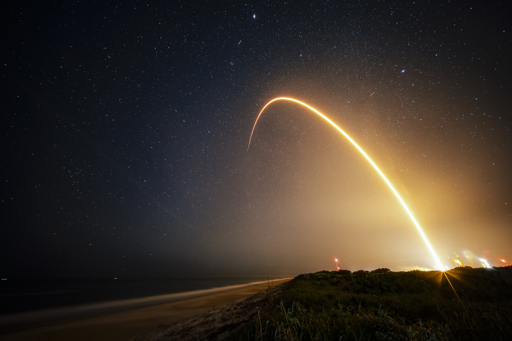Article text
Sandra Erwin
6–7 minutes
On Nov. 22 a SpaceX Falcon launched its 150th Starlink mission of 2025. The company has launched 2,814 satellites so far for the year. Credit: SpaceX
WASHINGTON — The Florida Space Coast passed a major milestone last week. The Starlink mission flown Nov. 20 marked the 100th orbital launch of the year, the first time Cape Canaveral and Kennedy Space Center have ever seen triple-digit activity in a single calendar year.
Col. Brian Chatman, commander of Space Launch Delta 45, said this is the new normal. “Next year, we are hearing and planning for somewhere in the 100 to 115-ish launches,” he said. That pace now forces the Space Force and launch companies to confront the reality that the Eastern Range remains, as Chatman put it, a “collection of assets since the Apollo era that we have continued to bolt on and tack on.” To keep up, the range needs a broad modernization effort. Preparing for Starship era
Chatman took command of Space Launch Delta 45 in June. Speaking with reporters Nov. 21, he said the focus next year will be on mapping out infrastructure upgrades and operational changes needed to handle more launches and more providers.
SpaceX’s steady stream of Starlink flights remains the dominant driver of volume, but the picture could change going forward. United Launch Alliance is expected to increase the cadence of its Vulcan rocket. Blue Origin is ramping up New Glenn flights. SpaceX also plans to bring its next-generation Starship to Florida. All this pushes launch tempo higher while adding complexity, said Chatman.
Congress backed range improvements by approving $1.3 billion through 2028 for the initiative called Spaceport of the Future, the largest investment in Cape infrastructure in 30 years. Next month, Space Delta 45 and NASA’s Kennedy Space Center will sit down with launch providers to work through what needs to change and, as Chatman put it, “what do we need to remove, as far as choke points go, to be able to support tomorrow?” Clearing people out of the blast zone
One practical change already underway is simple but impactful. The Space Force is moving offices and workspaces out of the active launch complexes and into a separate industrial area. Today, personnel often must evacuate pads and nearby buildings for safety, which slows day-to-day work. Relocating these functions allows operations to continue even as rockets roll to the pad, fuel up or enter countdown.
Security checkpoints are also getting an upgrade. Chatman said the base is adding digital scanners to speed vehicle inspections. Trucks carry everything from propellants to cryogenic fluids to telecommunications gear. Faster screening means smoother flow of “commodities” — the catch-all term for the supplies needed to prep rockets.
Now, all providers except ULA’s Atlas 5 fly with Automated Flight Termination Systems (AFTS), which can detect an anomaly and self-terminate without waiting for a ground command. This cuts the time between missions, because the ground segment no longer needs hours of setup and coordination for each flight. The result is shorter “deconfliction” periods, the buffer time the range requires to reset and verify safety systems.
Deconfliction is harder when launches are from different providers, Chatman noted. Each rocket type uses different radio frequencies, which means the range must schedule spectrum deconfliction so flights do not interfere with one another. Different rockets also need different commodities, such as unique propellants or specialized ground support equipment. SpaceX can fly two Falcon missions hours apart because its operations are highly standardized. Blue Origin and ULA use different infrastructure, slowing planning and pad turnaround. New support contract to modernize range
To help manage range improvements, the Space Force selected Amentum for the Space Force Range Contract, a 10-year deal worth up to $4 billion. It covers maintenance, sustainment, engineering and integration work across both the Eastern Range in Florida and the Western Range at Vandenberg Space Force Base in California.
Chatman said he could not share details about the contract because it’s still in the early transition phase. He said the range needs a top-to-bottom review. Right now, the facilities remain “a collection of assets since the Apollo era that we have continued to bolt on and tack on to to ensure we have the right telemetry, the right safety, the right termination systems … so maintaining and sustaining that is a huge approach.”
Space Launch Delta 45 is working with Space Systems Command to define what the “range of tomorrow” should look like.
A looming change is SpaceX’s plan to begin launching Starship from Florida. The massive vehicle requires its own pads, ground systems, commodity lines and safety analysis.
“We’re working in partnership with Kennedy Space Center to build out launch complexes for Starship operations,” Chatman said. “KSC is leading the way with Space Launch Complex 39 A and the partnership with SpaceX there to do the development work to be able to support Starship.”
The range expects Starship operations to begin in early to mid 2026. “And we’ll have the range ready to support it at that time,” he said.


